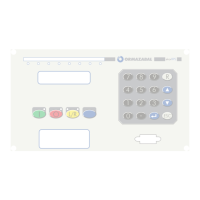IG-150-EN version 04; 03/10/16
89
General instructions
ekor.rps
Protection functions. Description and settings
The algorithm stores the periods of the last 5 cycles of the
signal and calculates the frequency derivative comparing
the frequency measurement of the present cycle with the
measurement 5 cycles before having in account the time
space between both.
df/dt = (f1 - f5)/(T1 + T2 + T3 + T4)
f(Hz)
f1
f2
f3
f4
f5
T4
T3
T2
T1
t
s
α=Arctan(df/dt)
f5 = frequency measurement 4 cycles ago
f4 = frequency measurement 3 cycles ago
f3 = frequency measurement 2 cycles ago
f2 = frequency measurement 1 cycle ago
f1 = last frequency measurement
T4 = period of the 4
th
cycle starting from the end
T3 = period of the 3
rd
cycle starting from the end
T2 = period of the 2
nd
cycle starting from the end
T1 = period of the last cycle
Figure 4.22. period of the last 5 cycle signal
This calculus is repeated having in account the
measurements separated by two cycles so that it makes
sure that the frequency has been falling the whole time,
that is, it is not a spurious measurement that can lead to a
trip.
For the unit to pickup, the frequency derivative must be
exceeded in module during the set number of cycles minus
4 cycles. That is, if it is set to 5 cycles the frequency rate of
change must be viewed repeated once in order to pickup.
If the setting is 4 or lower the unit picks up the rst time the
measurement is viewed above the threshold (in absolute
value).
The pickup happens only if the value of df/dt is negative,
that is if the present frequency value is lower than the value
5 cycles before.
During the pickup process one measurement is allowed to
be out of the pickup range without restarting the process.
That is, if for example 3 cycles (set to 7 cycles) are required
to cause pickup, it is enough if the threshold is exceeded 3
times out of 4 consecutive measurements.
Once the unit has picked up, for it to trip, the frequency rate
of change measurement must remain between the value of
df/dt set and a dropout value equal to df/dt minus 0.05 Hz/s
during the set time.
If some of the inputs are programmed as breaker associated
to the frequency gradient, the trip is locked until that output
is viewed open.
Once the unit has picked up, for it to dropout the
measurement of df/dt must be seen 0.05 Hz/s below the set
value.
Figure 4.23. Logic

